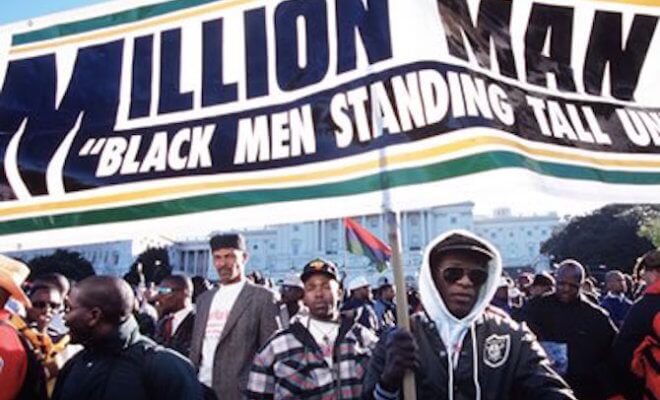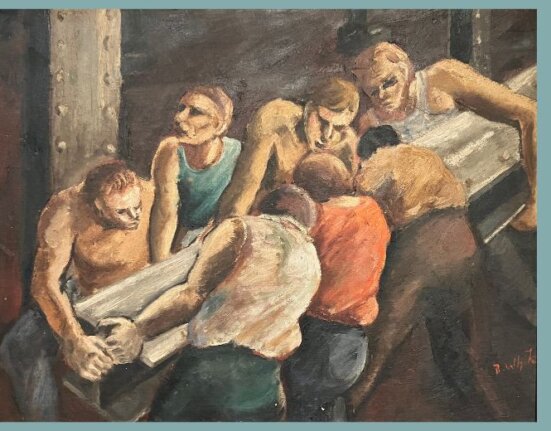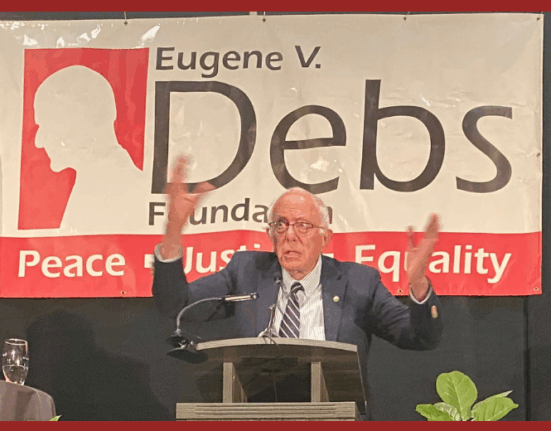In 1995, I co-authored a critical response to the Million Man March, an event that is the focus of a twentieth-year commemoration this month. Published in New Politics in 1997, the article (“Providence, Patriarchy, Pathology: Louis Farrakhan’s Rise and Decline”) was among the few responses from the black left that was direct in its reproach. Sundiata Keita Cha-Jua and I took issue with the racial, class, and gender politics of the event, as well as the message of its chief spokesman, Minister Louis Farrakhan of the Nation of Islam. We argued that while the Washington, D.C., gathering powerfully illustrated the restless search for answers among black urban communities during the supposedly prosperous years of the Bill Clinton presidency, it departed dramatically from the history of mass marches on the nation’s capitol.
Previous episodes, like the threatened 1941 March on Washington against racial discrimination in the military and defense industries, the 1963 March on Washington for Jobs and Freedom, or the 1969 Moratorium March on Washington to End the War in Vietnam, were protests demanding the federal government to enact reformist legislation or alter an existing policy. In contrast, the sojourners to D.C. in 1995 were asked to essentially protest themselves. Notwithstanding speakers’ bold denunciations of white racism, the rhetoric of the march overwhelmingly castigated African Americans – particularly African Americans males – for their failures as spouses, fathers, and other pillars of their communities, and called on them to “atone,” accept “responsibility,” and otherwise assume their proper duties as men. Although the admonition was delivered in class-neutral terms, the stereotypical referent in this “tough love” preaching to black audiences – whether offered by Farrakhan, President Barack Obama, or Bill Cosby in his 2004 “Pound Cake” speech – has usually been the black “underclass” lacking in reputedly “middle class” characteristics such as personal discipline, respect for delayed gratification, self-reliance, and a regard for hard work.
In the meantime, the march’s theme of personal “atonement” buried attention to deteriorating black economic conditions, which was a consequence of the political right’s larger assault on the piecemeal legacies of the liberal New Deal and Great Society. Black “atonement” not only failed to account for the retreat from the social safety net and civil rights protections that had been happening since the Ronald Reagan presidency, but it also avoided reckoning with an accelerating “war on drugs” that was criminalizing and incarcerating record numbers of black working-class people in the ‘90s. Ideologically, the organizing premises of the Million Man March shared far more in common with the “Contract with America,” forged by Newt Gingrich and a Republican-dominated Congress, than it did with the black freedom movement mobilizations with which many observers compared it.
Undeniably, expecting individuals to be accountable to their families, neighbors, communities, and fellow citizens is necessary and appropriate. Yet, calling for personal responsibility in the absence of social and economic justice implicitly blames the victim. In some cases, this can produce well-intentioned yet clumsy efforts at “correcting” individual behavior through role modeling, tutelage and private voluntarism, as with President Obama’s “My Brother’s Keeper” initiative. Too often, though, this outlook leads to outright punitive measures.
In the case of black males, moreover, sternly lecturing them on the virtues of fatherhood rested largely on assumption. At the time of the march, my future colleague and partner, sociologist Jennifer Hamer, was at work on her first book, What It Means to be Daddy: Fatherhood for Black Men Living Away from Their Children. She revealed that poor working-class African American males are far more actively engaged in their children’s lives than popular discourse, both inside and outside black communities, would lead us to believe. Moreover, the march’s emphasis on personal responsibility was dishonest in a context in which corporations were shedding their civic responsibilities in an orgy of deregulation, employee downsizing, capital disinvestment, anti-tax resistance, and financial speculation. Aided and abetted by Democrats and Republicans alike, finance capitalists were then intensifying an ongoing redistribution of public resources to private coffers, contributing to the austerity and gross asymmetries of wealth that we experience today.
But aside from whether Farrakhan was right or wrong in his admonitions to black men, the male-centered complexion of the Million Man March silenced a range of issues, interests and demands particular to black women. This outcome reflected another popular school of thought that had been pervasive at least since the 1965 publication of The Negro Family: The Case for National Action by then-Assistant Secretary of Labor Daniel Patrick Moynihan. The “Moynihan Report,” as it was known, posited that black poverty was predominantly the result of cultural dysfunction stemming from the prominence of female-headed households and “black matriarchy” in African American communities. Here again, the failure of black gender-based duties was rendered in class terms: that is, the chief symbol of the breakdown in black “family values” was the government-dependent “welfare mother” living on the margins of the working class with her multiple children born out of wedlock.

The logic of this argument in both 1965 and 1995, as well as today, is that if black men would simply “take charge” or “restore” themselves to the guardianship of the family, they would solve everything that ails Black America. In this regard, the Million Man March mirrored the efforts of the Promise Keepers, a conservative white Christian men’s organization dedicated to religious and moral uplift through male leadership. At best, the march’s underlying principles reinforced calls for jobs and other programs that would increase the pool of “marriageable” men. At worst, this position has legitimated reactionary efforts at the state level to impose the institution of marriage on the poor. In both scenarios, patriarchy is the all-purpose remedy to racial and economic inequality. This approach not only naturalizes a specific set of gender norms with regard to such matters as household organization and authority over women’s bodies, but it also enforces a corresponding vision of sexual norms within which, for instance, same-sex partnerships would be judged as aberrant. Indeed, patriarchy concerns not only male-centered dynamics of power but also other forms of hierarchy. Consequently, if women are imagined as junior partners who, like youth and the “unrespectable” poor, need to be assigned their proper subordinate role, then lesbian, gay, bisexual, transgender, and queer (LGBTQ) African Americans are either to be “cured” of their deviance or banished from the fold altogether.
As has been the case among aggrieved groups in other historical moments of social and economic calamity, the Million Man March responded to the crisis of mass incarceration and black communal disintegration by resorting to “tradition” and “order” instead of meaningful social transformation. I hasten to add, though, that one should distinguish the march’s platform from the multitude that assembled in the National Mall in October 1995. Many participants returned home energized to render service to their neighborhoods and communities through educational reform, reentry programs for ex-felons, economic development, youth mentoring, voter registration, and grassroots efforts against rampant gun violence. The march also inspired several sequels, including the Million Woman March in 1997 and two Million Youth marches in 1998. However, for Sundiata, Jennifer, me, and many others, the reactionary ideas underlying the march strengthened our resolve to find more progressive black political vehicles, or create them. We subsequently were among the 3,000 people who trekked to Chicago in the summer of 1998 to found the Black Radical Congress.

Unlike its predecessor, the Million Man March’s recent twentieth-anniversary gathering in D.C. did feature state-directed calls for justice. This was a reaction to several post-1990s developments – most especially the emergence of social media technology, which has been a potent tool of publicizing police and vigilante terror, and rapidly mobilizing people in discursive communities of interest and affinity. The content of black freedom activism is also changing in the twenty-first century. In articulating emancipatory perspectives on gender, sexuality and class – not to mention exposing the structural nature of racism – the burgeoning “Black Lives Matter” movement today is miles ahead of the overall thrust of the 1995 Million Man March. Black women crafted the “Black Lives Matter” slogan, and they have been notable in leading and peopling many of its associated campaigns. In the ongoing “Fight for 15” among fast food workers around the nation, women and mothers of color also have demanded living wages and union protections in order to secure autonomous households and a dignified existence independent of (male) partners.
Black men, too, merit support for the actual roles they do play in their children’s lives, even if they do not inhabit the same household. Likewise, both black males and females deserve fair and full employment, accessible health care, educational opportunity, affordable and safe housing, equitable metropolitan development policy, and protections against police abuse and rapacious municipal courts, whether or not they choose to marry the mothers or fathers of their children – or however else they create domestic spaces. To be sure, many activists have reminded us that black lives can’t be fully realized as long as LGBTQ issues and concerns remain disposable or outside the vein of “legitimate” black politics. And members of the so-called black “underclass” are rejecting the conventions of “respectability” in favor of speaking brutal truth to power, even if their speech, appearance and manner embarrass middle-class black leaders and spokespersons intent on putting their best foot forward beneath a white gaze.
We certainly should reflect on the legacies of the 1995 march. But we should avoid its guiding precepts, which have buttressed, rather than defied, sources of continuing black suffering today.








2 Comments
Comments are closed.